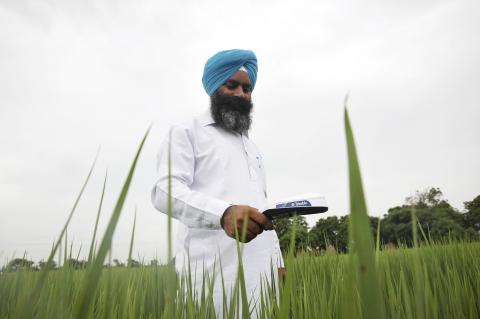Erratic weather, rising temperatures, declining water resources and labor shortages are threatening India’s bread basket state of Haryana, forcing farmers to abandon age-old practices and adopt technology to ensure food supplies for millions.
Using machines that sow rice directly, devices to inform when to irrigate and phone messages warning of infestations, thousands of farmers are learning to adapt to climate change, boost soil fertility and reduce their carbon emissions.
“At first, many farmers were unsure. It’s a big risk to change the way you have farmed for decades and try new things. Agriculture in these parts is not just a livelihood, it’s a way of life,” said Harpreet Singh, 36, a farmer in the village of Birnaraya, 130km north of Delhi.

Photo: Reuters
“But over the last four years, through these technologies, we have learned to save water and fertilizers, cut our costs for hired labor, improved the resilience of our crops and also reduced pollution by not burning crop residues,” he said.
Singh is from one of 12,000 farming households across 27 villages in Haryana’s Karnal District working with scientists from the Consultative Group on International Agricultural Research to pilot climate smart techniques aimed at sustaining one of the nation’s most fertile belts.
Since India’s so-called “Green Revolution” — a massive government program rolled out in the 1960s and 1970s that increased the use of fertilizers and irrigation to boost farm output — Haryana’s rice production has soared to almost 4 million tonnes in 2013-2014 compared with 334,000 tonnes in 1966-1967.
However, while the Green Revolution may be credited with ending famine across the country, it has come at a cost and, coupled with more unpredictable weather attributed to global warming, India’s food security is once again at risk.
Almost half a century on, farmers face environmental problems such as depleted groundwater because of intensive pumping for irrigation, soil degradation and soil salinity.
“Resources are depleting. Groundwater levels are falling, there is emerging climate variability, the soil health is worsening and profitability is going down,” said M.L. Jat, an agronomist with the International Maize and Wheat Improvement Center.
The Indo-Gangetic Plains — which include the rice and wheat states of Haryana and Punjab — are particularly vulnerable to climate change, experts from the UN Intergovernmental Panel on Climate Change say.
Scientists predict average temperatures here would increase by as much as 5°C by 2080, seriously affecting wheat crops. An April study by the Indian Agricultural Research Institute projects climate change may reduce India’s wheat yield by between 6 and 23 percent by 2050.
Rice will also be hit due to unpredictable rainfall. Indian officials say the water table has fallen between 1m and 13m in different parts of Karnal over the past two decades.
The region, which is heavily dependent on migrant labor from poorer states, is also facing shortages due to a government scheme to employ more people in construction near their homes.
In response to these challenges, agricultural groups are introducing Karnal’s farmers to a host of climate smart technologies.
These include techniques such as direct seeding, which involves sowing seeds by machines rather than transplanting manually, reducing labor and water.
Other new technology includes laser lavelers — tractor-towed, laser-controlled devices that produce a flat surface for cultivation, requiring 25 to 30 percent less water.
Farmers are being introduced to tools such as “Happy Seeders,” which can be attached to the back of tractors. These remove crop residues, blending them into the soil, preventing the practice of burning crop residues that has led to increased emissions and depleted soil fertility.
“We didn’t know anything about these advanced technology machines before,” said Manoj Kumar Munjal, 40, who farms an 8-hectare plot of land in Taorori Village.
“We have learned about these machines and set up a cooperative where we all put in the money together and bought machines and share them. Now everyone is using it,” he said.
Farmers also receive voice messages giving weather forecasts, informing them of new seed varieties and infestations.
However, these technologies do not come cheap. A laser leveler, for example, costs more than US$6,000.
In villages such as Munjal’s, farmers have clubbed together to buy new machinery, while in others, one farmer invests in the hardware and rents it out to others.
The Consultative Group on International Agricultural Research said a similar project is under way in the eastern state of Bihar using lower cost techniques on smaller plots.
On his sprawling 36-hectare farm, Harpreet Singh crouched down amongst his rice paddy stalks and checked his tensiometer, a device planted in the ground to measure moisture content.
Singh said that over the past four years, his income has increased by 15 percent due to savings made on electricity for irrigation, diesel for residue burning, labor and fertilizers. However, it is the saving on water that satisfies him the most.
“Day by day, the ground water levels are going down and down. If we continue like this, it’s only a matter of time before we don’t have water to drink, let alone to farm,” he said.

A wave of stop-loss selling and panic selling hit Taiwan's stock market at its opening today, with the weighted index plunging 2,086 points — a drop of more than 9.7 percent — marking the largest intraday point and percentage loss on record. The index bottomed out at 19,212.02, while futures were locked limit-down, with more than 1,000 stocks hitting their daily drop limit. Three heavyweight stocks — Taiwan Semiconductor Manufacturing Co (TSMC, 台積電), Hon Hai Precision Industry Co (Foxconn, 鴻海精密) and MediaTek (聯發科) — hit their limit-down prices as soon as the market opened, falling to NT$848 (US$25.54), NT$138.5 and NT$1,295 respectively. TSMC's

SELL-OFF: Investors expect tariff-driven volatility as the local boarse reopens today, while analysts say government support and solid fundamentals would steady sentiment Local investors are bracing for a sharp market downturn today as the nation’s financial markets resume trading following a two-day closure for national holidays before the weekend, with sentiment rattled by US President Donald Trump’s sweeping tariff announcement. Trump’s unveiling of new “reciprocal tariffs” on Wednesday triggered a sell-off in global markets, with the FTSE Taiwan Index Futures — a benchmark for Taiwanese equities traded in Singapore — tumbling 9.2 percent over the past two sessions. Meanwhile, the American depositary receipts (ADRs) of Taiwan Semiconductor Manufacturing Co (TSMC, 台積電), the most heavily weighted stock on the TAIEX, plunged 13.8 percent in

In a small town in Paraguay, a showdown is brewing between traditional producers of yerba mate, a bitter herbal tea popular across South America, and miners of a shinier treasure: gold. A rush for the precious metal is pitting mate growers and indigenous groups against the expanding operations of small-scale miners who, until recently, were their neighbors, not nemeses. “They [the miners] have destroyed everything... The canals, springs, swamps,” said Vidal Britez, president of the Yerba Mate Producers’ Association of the town of Paso Yobai, about 210km east of capital Asuncion. “You can see the pollution from the dead fish.

ASML Holding NV, the sole producer of the most advanced machines used in semiconductor manufacturing, said geopolitical tensions are harming innovation a day after US President Donald Trump levied massive tariffs that promise to disrupt trade flows across the entire world. “Our industry has been built basically on the ability of people to work together, to innovate together,” ASML chief executive officer Christophe Fouquet said in a recorded message at a Thursday industry event in the Netherlands. Export controls and increasing geopolitical tensions challenge that collaboration, he said, without specifically addressing the new US tariffs. Tech executives in the EU, which is